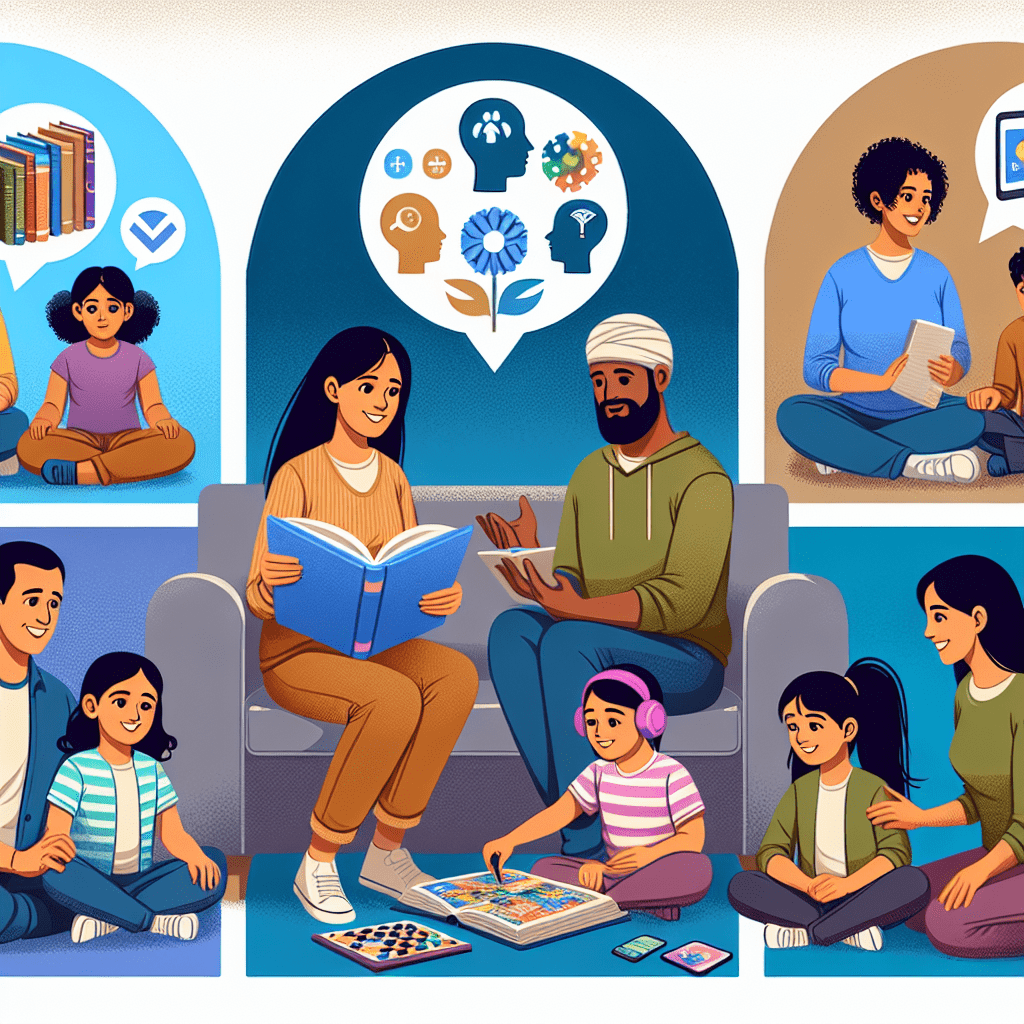Get your free Book Here

5 Simple Strategies to Promote Mental Health Awareness in Your Family
In today’s fast-paced world, where stress and anxiety seem to lurk around every corner, promoting mental health awareness within the family is not just essential—it’s a transformative experience. Mental health, much like physical health, requires attention and care. As a life coach, I have seen the positive impacts of fostering a supportive environment that encourages open discussions about mental health. In this blog post, we’ll explore five simple strategies to promote mental health awareness in your family.
Chapter 1: Open the Line of Communication
The foundation for mental health awareness starts with open communication. Encourage your family members to share their thoughts and feelings without the fear of judgment. How can you do this?
-
Create a Safe Space: Establish a setting where everyone feels comfortable discussing their emotions. It could be a weekly family meeting or a casual Friday night chat.
-
Normalize Conversations: Share your experiences with stress, anxiety, or happiness. Use phrases like “I feel” or “I’ve been struggling with…” to demonstrate vulnerability and openness.
-
Active Listening: When someone in your family shares, listen intently. Validate their feelings rather than jumping to solutions or dismissing their emotions.
Communication is key to reducing stigma around mental health and laying the groundwork for support and understanding in your family.
Chapter 2: Educate and Raise Awareness
Understanding mental health is the first step to promoting it. Educate your family about common mental health issues, warning signs, and the importance of seeking help. Here are some ways to do this effectively:
-
Family Workshops: Organize family workshops or invite a guest speaker who specializes in mental health. This can provide valuable insights and resources for everyone.
-
Utilize Resources: Share books, articles, or documentaries that illuminate mental health topics. Encourage family members, especially kids and teens, to explore these materials.
-
Discuss Myths vs. Facts: Take time to debunk common myths about mental health and replace them with facts. This can empower family members to speak out against stigma.
By educating your family, you’ll cultivate a culture of understanding and compassion, enabling them to support each other through life’s challenges.
Chapter 3: Encourage Healthy Lifestyle Choices
Physical health is inherently tied to mental health. Encouraging your family to adopt healthy lifestyle practices can dramatically improve their well-being.
-
Nutrition Matters: Cook wholesome meals together, focusing on nutrient-rich foods that promote brain health. Explain how certain foods affect mood and energy levels.
-
Physical Activity: Engage in family activities, such as hiking, biking, or yoga. Regular exercise is proven to reduce anxiety and depression while boosting self-esteem.
-
Mindfulness Practices: Introduce mindfulness techniques like meditation or deep-breathing exercises. Consider doing these activities together to establish a routine that promotes mental clarity.
Encouraging a healthy lifestyle will help your family understand that well-being is a holistic endeavor, supporting both body and mind.
Chapter 4: Create a Routine of Check-ins
Regular check-ins about mental health can be a game-changer. By creating a routine, you help family members feel seen and supported. Here’s how to implement these check-ins:
-
Daily Family Check-Ins: Dedicate a few minutes each day for everyone to share how they’re feeling. Ask open-ended questions that promote discussion, such as “What was the best part of your day?” or “Is there something bothering you today?”
-
Weekly Reflection: At the end of each week, reflect on the highs and lows as a family. Encourage everyone to express one thing they appreciated and one thing that was challenging.
-
Plan Follow-Ups: If someone shares that they’re feeling down or anxious, make it a point to follow up with them in the coming days. This shows commitment and care.
By establishing a routine of check-ins, you foster an environment that prioritizes mental health and encourages vulnerability.
Chapter 5: Seek Professional Help When Needed
Sometimes, the best way to support a family member is to recognize when professional help is necessary. Here are some tips for approaching this sensitive subject:
-
Normalize Therapy: Share your thoughts on therapy as a positive resource rather than a last resort. Create a narrative around seeking help as an empowered decision.
-
Research Together: If a family member is open to the idea, spend time together researching mental health professionals in your area. Take away the fear of the unknown by making the search a joint effort.
-
Support Their Journey: If someone decides to seek help, offer your unwavering support. This could mean providing transportation to appointments or simply being there to listen post-session.
Understanding that professional help is a valuable tool encourages family members to take control of their mental health journey.
Conclusion
Promoting mental health awareness in your family is a continuous journey that requires patience, understanding, and commitment. By opening the lines of communication, educating your family, encouraging healthy lifestyle choices, establishing a routine of check-ins, and recognizing when professional help is needed, you set the foundation for a healthier, happier family dynamic. Remember, it’s not about perfection; it’s about progress. As you navigate this journey together, you’ll strengthen your bonds and cultivate an environment that deeply values mental well-being.
FAQs
1. How do I start a conversation about mental health with my family?
Begin with a personal experience or current event that highlights the topic. Encourage questions and actively listen to their responses.
2. What if my family member is resistant to discussing mental health?
Respect their space while gently reminding them that support is available whenever they’re ready. Creating a safe environment over time may encourage openness.
3. Are there specific resources you recommend for family mental health education?
Books like "The Body Keeps the Score" by Bessel van der Kolk or "Feeling Good: The New Mood Therapy" by David D. Burns are excellent places to start.
4. How do I handle negative reactions when discussing mental health?
Stay calm and validate their feelings. Explain why mental health matters to you, aiming for an open dialogue that may shift their perspective.
5. Should we involve children in mental health discussions?
Yes, absolutely! Kids can understand emotions at different levels. Use age-appropriate language and situations to teach them about mental health and emotional well-being.
Instantly Access Your Free Children’s Books Here! (https://payhip.com/BlueCherryStore) – Disclaimer: As an Amazon Associate, I earn from qualifying purchases, I may earn a commission from qualifying purchases as an affiliate. Please note that I only recommend products I believe will provide value to my readers. (M)







